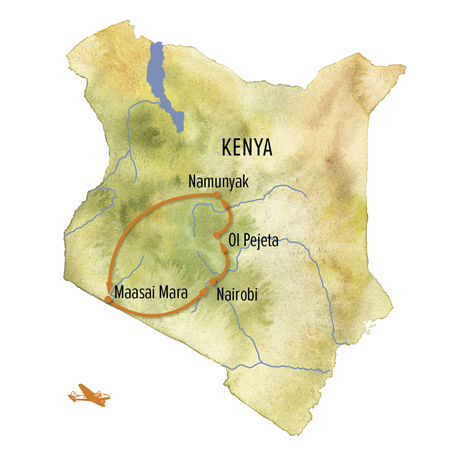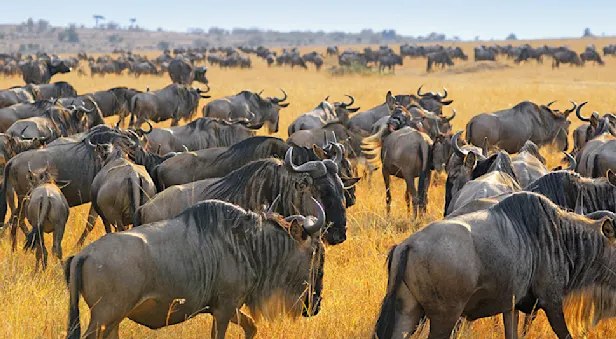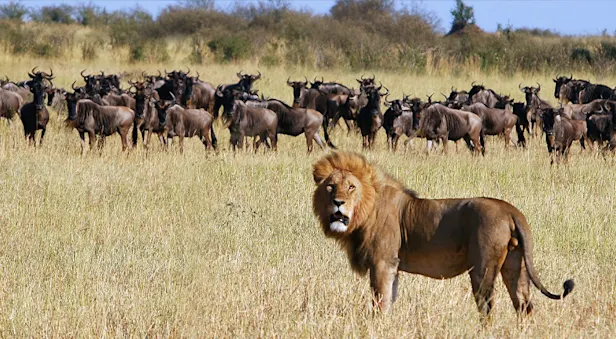Itinerary

Our Kenya safari begins in Nairobi, with a transfer from the airport to our boutique hotel in the quiet residential suburb of Karen on the outskirts of the city. This area at the foot of the Ngong Hills is named for Danish author Karen Blixen, also known by her pen name Isak Dinesen, who wrote the famous memoir Out of Africa chronicling her life on a Kenyan coffee plantation in the early 20th century. This evening, enjoy a welcome dinner with our Expedition Leader and a preview of our safari adventures ahead.
After breakfast, meet your guide and head out for your first wildlife experience, a morning game drive in nearby Nairobi National Park. Designated as a protected reserve by the British colonial government in 1946, this 45-square-mile park on the outskirts of the city is home to black rhino, lion, leopard, cheetah, hyena, buffalo, giraffe and diverse birdlife, with more than 400 species recorded. Here, we'll have our first rhino encounter and introduction to this very special endangered species.
After our safari and a picnic lunch in the park, continue to the Sheldrick Wildlife Trust, which operates the most successful elephant rescue and rehabilitation program in the world. The trust's pioneering programs for orphaned elephants—rhinos, too—are a leading inspiration for conservation work in East Africa, with numerous wildlife and habitat protection successes to tout. On a private visit to the Daphne Sheldrick Elephant Orphanage, learn about its history and mission, how the baby elephants here were rescued, and what their care involves until they can be released back into the wild. We'll meet their keepers, watch a feeding, and likely observe some mud bath play as well.
Then it's on to Nairobi's famous Giraffe Center, established in 1983 to protect the endangered Rothschild's giraffe found only on the grasslands of East Africa. The Giraffe Center is the creation of the African Fund for Endangered Wildlife, a Kenyan non-profit whose main purpose is to provide educational programs for Kenyan youth about the country's wildlife and environment, and to offer visitors a chance to come into contact with the world's tallest species, the giraffe. The center has introduced several breeding pairs of Rothschild's giraffe into Kenyan national parks. You’ll stand up high on platforms to engage eye-to-eye with these gentle giants, and a chance to feed them by hand is lots of fun.
Fly north to the renowned Ol Pejeta Conservancy, located on the Laikipia Plateau. A working cattle ranch established in the 1940s during Kenya's colonial days, Ol Pejeta set aside land for rhino conservation in 1988 and has become a highly regarded trailblazer for conservation innovation. Today it is the largest black rhino sanctuary in East Africa and home to the world’s last two remaining northern white rhinos, a staunchly guarded pair of females that we visit in person, learning about their fate and future with a local conservation expert.
With their sharp, swooping horns, large nostrils, whimsical ears and wrinkled, armor-like hides, Africa’s rhinos look both ferocious and charming. The world's largest land mammal after elephants, rhinos can weigh more than two tons. They are among the oldest mammals on Earth, roaming the continent for millions of years. Yet this mighty, enduring beast is threatened with extinction as poaching has decimated its numbers. But hope glimmers, as concerted conservation efforts are helping rhinos step back from the brink.
The conservancy is also home to the endangered Grevy's zebra and has some of Kenya's highest predator densities, yet it still manages a very successful livestock program. Ol Pejeta seeks to preserve the exceptional biodiversity within its 90,000 acres while supporting the people living on its borders, to ensure that wildlife conservation translates to better education, healthcare and infrastructure for the next generation of wildlife guardians. In 2014, Ol Pejeta achieved IUCN Green List status, one of only two conservancies in Africa to be so recognized. The Green List aims to define excellence in managing valuable natural areas.
Nat Hab's Rhino Camp inside the conservancy is the ideal base from which to explore this diverse wildlife haven that contains many of Kenya's endemic northern species. We'll hope to see the legendary Big Five and much more on day and night wildlife drives and guided walks against the backdrop of snowcapped Mount Kenya. At the end of each exhilarating foray into the bush, return to the comforts of our tented camp, redolent with the ambience of East Africa's classic safari era.
A short chartered flight takes us to the Namunyak Community Conservancy in the heart of Kenya’s northern frontier. Backdropped by the dramatic Mathews Range, this land is home to the Samburu people, semi-nomadic pastoralists who have raised livestock here for centuries while coexisting in harmony with the region’s striking wildlife. Namunyak is one of Kenya’s most pristine wilderness areas, serving as a critical refuge for many wildlife species, with important northern populations of reticulated giraffe, gerenuk, leopard, African wild dog, impala lion, greater kudu and many different birds. The conservancy is particularly important for elephants as they move seasonally between the Mathews Range and the Ngare Ndare Forest near Mount Kenya, a route they have used for decades.
Our base for exploration is Nat Hab’s Elephant Conservation Camp, where seclusion, comfort and exceptional service are hallmarks of this exclusive experience. Our stay includes a private visit to Reteti Elephant Sanctuary, the world’s first such enterprise owned by Indigenous community members. The sanctuary was designed to rescue and release orphaned and abandoned elephant calves while creating much-needed benefits for the local people that live alongside them—inspiring them to recognize the intrinsic value of nature and protecting local wildlife for its benefit to their own well-being.
We have the rare opportunity to go behind the scenes to meet the dedicated local caretakers and to witness firsthand how Reteti is transforming elephant conservation. Observe feeding time, learn the elephants’ individual stories, and support a model of conservation that uplifts both wildlife and the surrounding Samburu community. We’ll also take game drives and guided bush walks to look for roaming elephants and other wildlife, punctuated with peaceful interludes at camp. The entire experience offers a soulful connection to northern Kenya’s people, animals and landscapes—one that few travelers are privileged to encounter, and one that will certainly ignite your own passion for conservation.
Transfer this morning to the airstrip for our flight to Kenya’s famed Maasai Mara. Our first safari destination in the Mara is a vast private conservancy offering unparalleled access to wildlife viewing. Nat Hab's own mobile camp on the Olderkesi Conservancy features bush luxury in classic canvas tents, surrounded by all the natural wonders of the Maasai Mara ecosystem without the crowds. The conservancy model has been a boon to the region's legendary wildlife, creating buffer zones and protecting migration corridors while providing economic benefits to local landowners through responsible safari tourism.
On this private reserve, learn about conservation successes as we experience the Mara’s spectacular wildlife in peaceful solitude—with strict limits on guest numbers, our camp is one of just a handful located within its bounds, allowing for unprecedent wildlife viewing of the multitude of species that resides on the conservancy. Great herds of antelope dot the grassy, rolling plains while stands of acacia woodland shelter prolific birdlife. Rich volcanic soils nurture a verdant landscape where we find more lions per square mile than anywhere else in Kenya. Impressive herds of elephant, giraffe and zebra also roam the savanna. Our activities make the most of our unrivaled access to this vast, wild region. In addition to daily game drives, enjoy guided walks, bush picnics, off-road safaris and night drives in search of nocturnal wildlife—pursuits not permitted in the adjacent Maasai Mara National Reserve.
After a rich range of safari experiences, and inspired by the conservation triumphs Kenya has achieved for endangered rhinos, elephants and other wildlife, it's time to fly back to Nairobi today. On arrival, day rooms await for refreshment and relaxation. Later, we'll share a farewell meal to close our Kenya conservation safari before meeting evening departures for international destinations.
Interested in extending your trip? Link it up with another adventure!

Tanzania’s Great Migration & Ngorongoro Crater
Witness one of nature's most exhilarating spectacles: thousands of wildebeest and zebra making their annual trek across the Serengeti! Itineraries custom-designed to follow the herds.



































